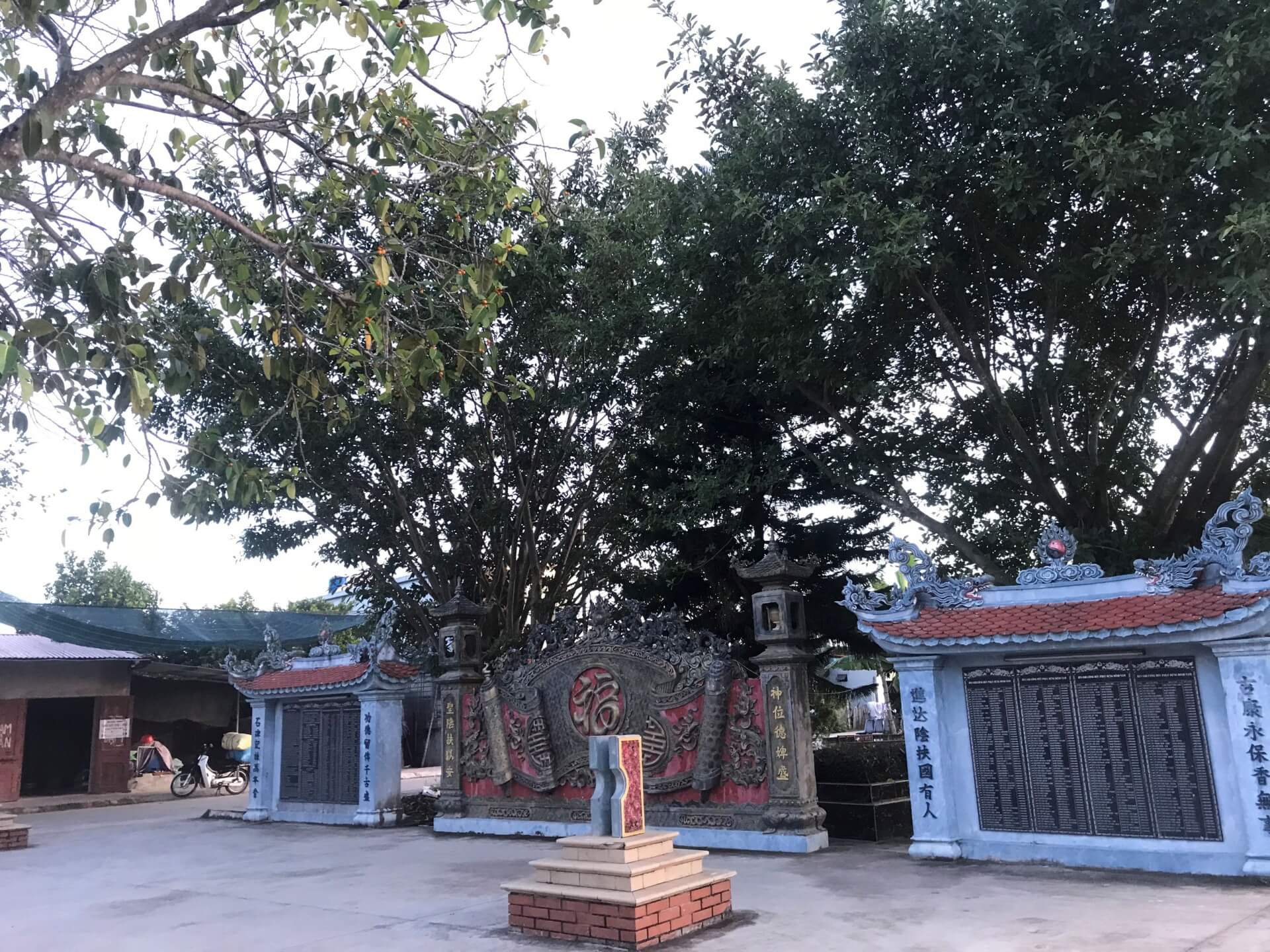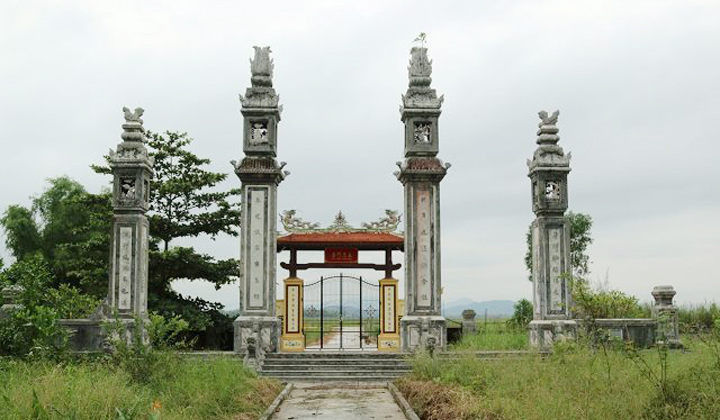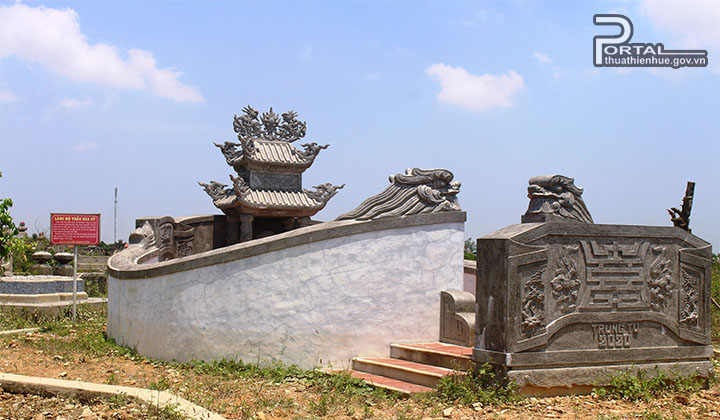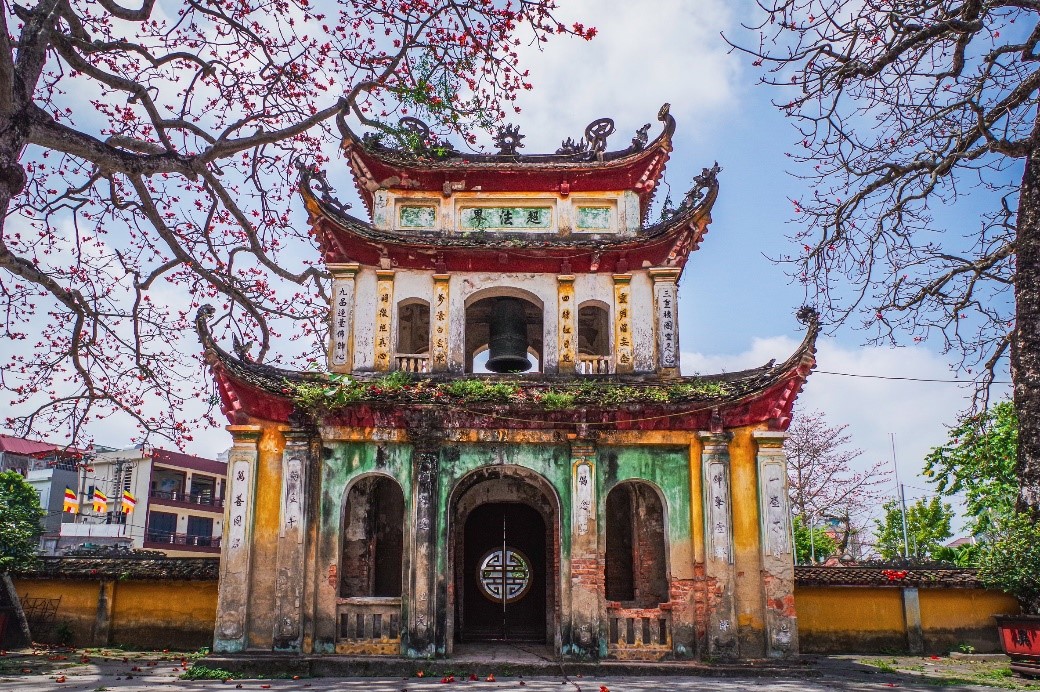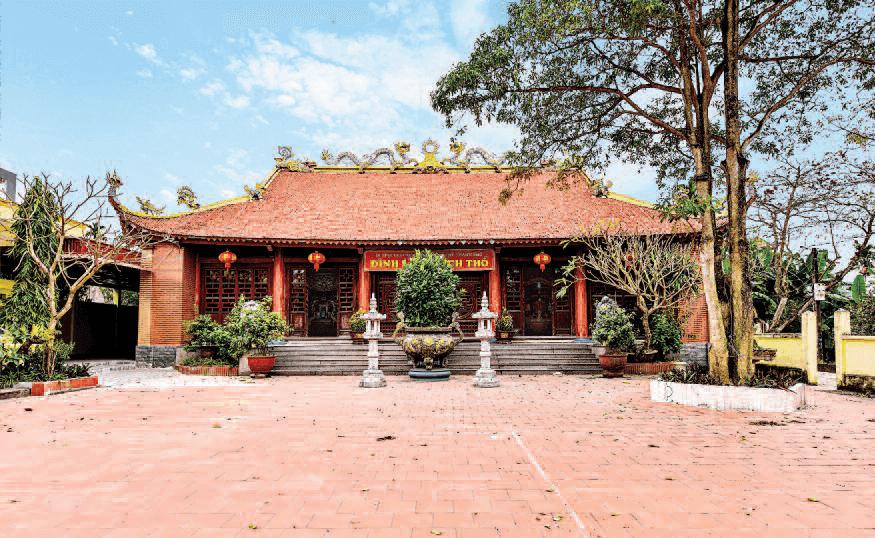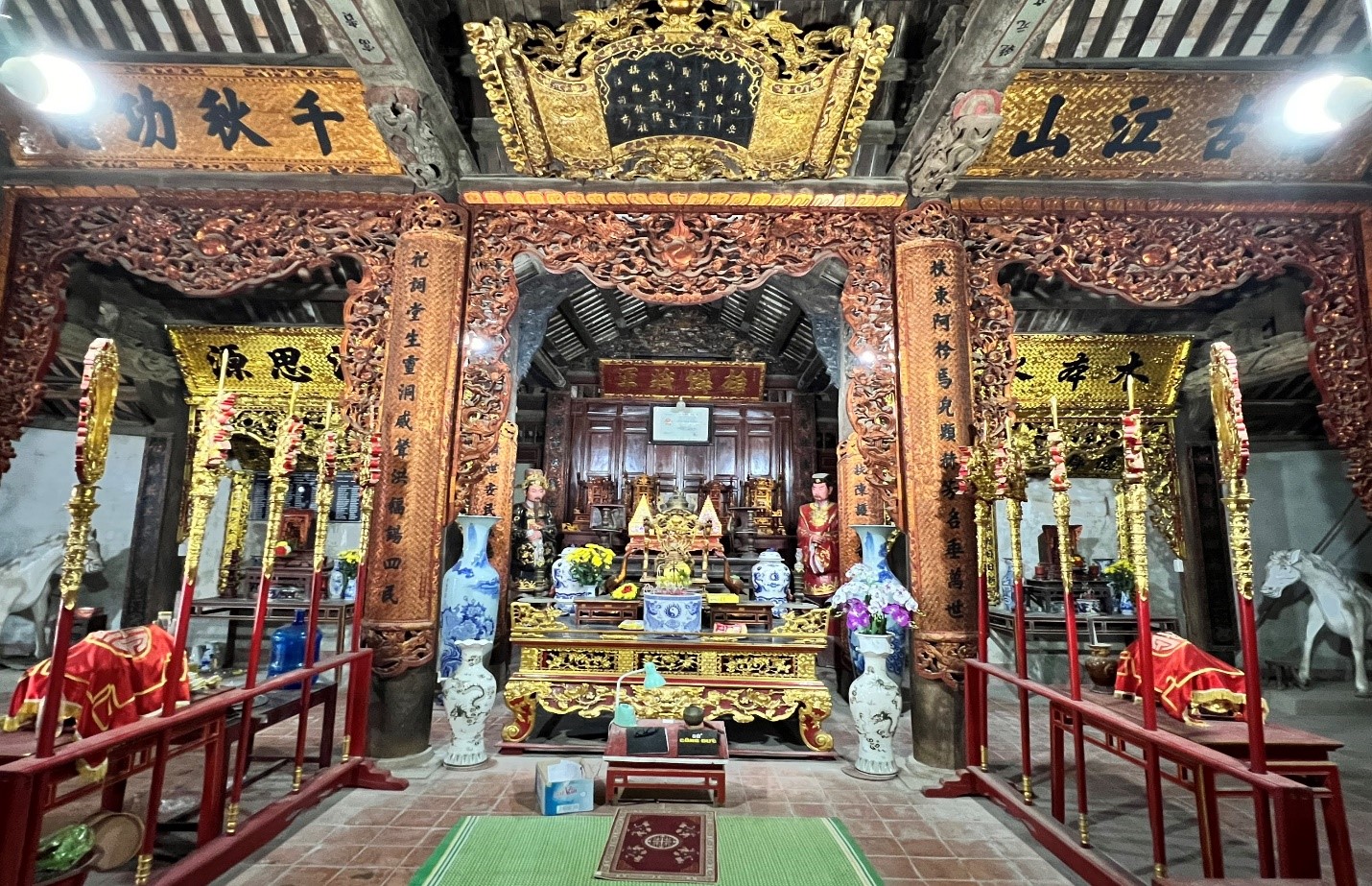Relic point Vietnam
Việt NamDinh Nhu Thuong
Nhu Thuong communal house in Quoc Tuan commune, An Duong district, Hai Phong worships two sisters Mai Thi Cau and Mai Ky Son, children of King Mai Hac De, the leader of the resistance against the Tang dynasty in the 8th century. Due to their existing friendship and close relationship with the Pham and Hoang families here, Mai Thi Cau and Mai Ky Son helped villagers with land, gold and silver, and recruited villagers to build camps. Joined the insurgent army, contributing to consolidating the dynasty of Mai Thuc Loan Dynasty. In the villages of Van Xa, Nhu Dieu, Kieu Yen Thuong today, they still have place names such as mandarin lagoon, soldier's land... originating from two sisters named Mai who provided each villager with 10 acres of arable land. After a fierce battle with the Tang Dynasty's colonial troops who came to suppress the uprising, Emperor Mai Hac sacrificed his life, and soldiers honored Mai Ky Son to succeed his father. Mai Ky Son's insurgent forces also occupied the Eastern and Southern regions of Tong Binh district for a long time. After more than 2 months, the enemy army was able to destroy the defense base of the two sisters Mai Ky Son in Kieu Yen Thuong, Nhu Dieu. Today, on the bank of an old tidal canal flowing into the Lach Tray River, in Quoc Tuan commune, An Duong district, there are still two small temples, one worshiping the older sister, the other worshiping the younger brother. Legend has it that this is the place where the villagers buried two people in the past, and this is where the tablets and incense bowls were placed. In the third month of the lunar calendar every year, the villagers hold the tutelage ceremony from the two temples to the communal house to hold the opening ceremony. Nhu Thuong Communal House has long become familiar with local people because of its grand architectural scale and delicate art of carving and engraving on wood, bearing the artistic style of the Nguyen Dynasty in the early 19th century. The communal house has a Dinh-style structure, consisting of 5 front halls and 3 majestic back halls built in the style of stacking matches, with roofs, 2 floors, 8 roofs much higher than the 5 front halls, built in the year of Tu Duc. 14 (1861). 20 years later, in the spring of Tu Duc 34 (1882), the villagers built 5 more front halls, connected to the back palace by taking advantage of wood and stone materials from the old riverside communal house. Nhu Thuong communal house was ranked as a historical and cultural relic by the State in 1991. SOURCE: Hai Phong City Electronic Information Portal
Hai Phong 2977 view
Dinh Nam
Nam communal house in Bac Son ward, one of the important religious buildings of the people of Do Son area, has just been restored. This is both a spiritual activity spot and a sacred destination in the city's famous tourist area. Located in the middle of a crowded residential area in the center of Do Son district, not far from the beach with waves crashing all year round, Nam communal house today has a moderate scale, bearing the appearance of ancient communal houses in the style of the Le Dynasty. The communal house has Dinh architecture, consisting of 3 compartments, 2 left, made mainly of wood and green stone. The curved, curved roof system with intricate carvings of four sacred animals bears the mark of the 15th century. In particular, all 38 wooden columns in the pavilion have a diameter of 34-45cm, carefully selected from tree trunks. Kien Kien - a precious wood, as hard as ironwood but tougher. Through the ups and downs of history, Nam communal house was completely destroyed twice. The first time around the 17th century, Nam Communal House was one of the military bases of He Nguyen Huu Cau District in Do Son. When Lord Trinh Doanh sent Hoang Ngu Phuc and Pham Dinh Trong to bring troops to suppress the uprising, the communal house was destroyed. After that, local people rebuilt the communal house with 5 rooms, 2 left, solemn and majestic. By the end of 1953, the communal house was destroyed again when the French colonialists forced the people here to move elsewhere, establishing a "white belt" in Do Son. In 1993, the Party Committee, PEOPLE'S COMMITTEE, Vietnam Fatherland Front and the people of Van Son ward rebuilt the communal house on the old foundation. At that time, due to economic difficulties, they only temporarily built a level 4 house and created a few wooden statues to serve as a place for people's spiritual and cultural activities. Since then, although it has been upgraded and repaired many times, the church space has seriously deteriorated, and the wooden statue system has been damaged by termites. In 2011, thanks to socialized funding, 6 worship statues were recast in gold-plated bronze. Based on the wishes of the people, the ward leaders were determined to restore the old communal house, starting construction in October 2014. The Nam Communal House Management Board is completing the grand pagoda, couplets and some details inside the communal house. The desire of the government and local people to continue expanding the communal house's grounds, restore the relic area and carry out relic recognition procedures SOURCE: Hai Phong City Electronic Information Portal
Hai Phong 2569 view
The palace worships Ton That Thuyet
The temple worshiping Ton That Thuyet is located in Van The Village, Thuy Thanh Commune, Huong Thuy Town, Thua Thien Hue Province. From Hue city center to An Cuu bridge (north bank) follow Provincial Road through Thanh Toan tiled bridge to Van The village to reach the relic (about 7km). Ton That Thuyet was born on March 29, Ky Hoi year (May 12, 1839) in Phu Mong hamlet, Xuan Hoa commune, Huong Tra district (now Kim Long ward - Hue city) in a family with a military tradition. belongs to room 4, generation 5 of the Nguyen Phuc family. His father was Admiral Ton That Dinh and his mother was Mrs. Van Thi Thu. During his career, he was appointed to hold many positions: Inspector of Hai Duong province, Deputy Commander of the Thai Nguyen Army, then Commander of the Deputy Commander of Son - Hung - Tuyen, Counselor, Military Advisor, Son Tay Police Department. , Palace Guard, Assistant Governor of Ninh Thai cum General Governor of Military Affairs of Ninh, Thai, Lang, Bang, Military Affairs Minister, Minister of War, Assistant Minister, General's Palace, Minister of Rites , Minister of Lai...He always has a master campaign to attack the French, in November 1873, his army and Luu Vinh Phuc's army defeated the French army at O Cau Giay, Hanoi. He wanted to take advantage of the victory to attack the enemy but the court wanted him to withdraw his troops to Son Tay, he refused. Great, the court had to send someone to discuss with him before he would retreat. In June 1874, when he was sent to Nghe An to deal with the uprising of Tran Tan and Dang Nhu Mai, when he took office, he showed sympathy and helped the Nghe Tinh Van Than movement. After Ham Nghi ascended the throne, Ton That Thuyet actively prepared to attack the French. He established the Phan Nghia and Doan Kiet armies, built the Tan So base and the Son Phong system, purchased and stockpiled weapons, strengthened the defense of the capital, encouraged scholars and literati and launched uncompromising struggles. concessions to pacifist and pro-French elements within the Court and Royal Family. On the night of July 4 to 5, 1885, Ton That Thuyet proactively organized an attack on French troops stationed at the Nunciature, Tran Binh Dai and the concession area. The attack failed. On the morning of July 5, 1885, he escorted King Ham Nghi to leave the capital to Quang Tri and then to Ha Tinh to launch the Can Vuong movement. In early 1886, after arranging and stabilizing the apparatus of the Ham Nghi Resistance Court, he went to the North to mobilize scholars, literati, and chiefs of ethnic minorities to rise up to fight the French. In early 1887, he went to China to ask for help from the Qing Dynasty, but the Manchu Dynasty at the request of France placed him under house arrest in Guangdong. He died in Thieu Chau on September 22, 1913. Ton That Thuyet's worshiping palace was originally the family's worshiping palace, built by Ton That Thuyet around the 19th year of Tu Duc's reign (1866). After Ton That Thuyet's death, the family took this Palace as a place to worship him. The Ton That Thuyet Temple Relic was recognized as a National Monument on October 15, 1994 in Decision No. 2754-Decision/Ministry of Culture and Information of the Ministry of Culture and Information (now the Ministry of Culture and Sports). Sports and Tourism). Source: Thua Thien Hue Electronic Information Portal.
Hue 2878 view
Tomb of Tran Van Ky.
Tran Van Ky mausoleum is located in Van Trinh village, Phong Binh commune, Phong Dien district, Thua Thien Hue province. Tran Van Ky was an outstanding scholar of the Tay Son dynasty. In 1777, Tran Van Ky passed the Nguyen Prize. In 1786, Tran Van Ky was invited by King Nguyen Hue of Bac Binh to ask about plans to control the rebellion. Admiring his talent, after returning from Quy Nhon to Phu Xuan, Nguyen Hue appointed him as Trung Thu Chinh (the person who drafts the king's official orders), holding all the secrets and advising Nguyen Hue. and was given the title of Marquis. Tran Van Ky played an important role in reorganizing the ruling apparatus in Dang Ngoai, recommending a number of famous figures to the state apparatus such as: Ngo Thi Nham, Phan Huy Ich, Vo Van Uoc, Nguyen The Lich, Vu Huy Tan..., organized a meeting between King Quang Trung and Nguyen Thiep, a famous scholar from Nghe An. During Quang Trung's reign, he had many contributions to help Quang Trung rule the country. After King Quang Trung died, Nguyen Anh prevailed, Tran Van Ky returned to his hometown, changed his name and changed his form to seek revenge. Being discovered, he had to go to the Phu Xuan capital. On the way to the Sinh intersection, he shouted "The loyal servant does not care about the two soldiers" and then jumped into the river and drowned himself to keep his dignity. He died on December 24. /1801 (November 19, Year of the Rooster). Tran Van Ky's grave is located on a high mound with an area of 11 square meters. The original tomb was previously covered in circular soil, 1m in diameter, the main tomb faced East, in front of the tomb was a 70cm high cement stele set up by Tran Van Ky's grandson in 1958. In 1995, the Thua Thien Hue Museum of History and Revolution Thien Hue restored the tomb. The round grave is kept intact, the top of the grave is sprinkled with gravel, a circle is built around it to protect the grave, and the grave is surrounded by a rectangular layer of concrete with moldings on all four sides. Tran Van Ky's tomb relic has been ranked as a national relic in Decision No. 534 -Decision/Ministry of Culture and Information dated May 11, 1993 of the Ministry of Culture and Information (now the Ministry of Culture, Sports and Tourism). Source: Thua Thien Hue Electronic Information Portal.
Hue 2863 view
Dinh Van Xa
Van Xa communal house is located in Huong Van commune, Huong Tra district (now Huong Van ward, Huong Tra town), Thua Thien Hue province. From Hue city, follow Highway 1A to the North about 13km, turn right along the village road to reach the monument. Van Xa Communal House was built in the year At Suu (1865) under Tu Duc's reign, and is one of the few communal houses with a large scale and typical architectural value in Thua Thien Hue. Van Xa Communal House was built on an area of about 1,600 square meters surrounded by walls on four sides. In front of the communal house is a semicircular lake planted with lotus. From outside, entering Van Xa communal house has the Tam Quan gate, screen, stele house, courtyard and communal house. The Tam Quan gate opens into three arched entrances, and the roof is cast with imitation yin and yang tiles. The screen is built in a honeycomb style, in the middle there is a stele house (engraved with content about the construction and restoration of the communal house). Van Xa Communal House is a three-compartment two-story house with a 400m2 ground floor, including 54 columns, including 8 main columns 5.2m high, 16 second columns (military columns) 3.6m high, 24 third columns (side columns). ) is 2.5m high and 6 fourth columns (porch columns) are 1.5m high. Sophisticated carved truss system. The decorative art of Van Xa communal house is mainly "Four Spirits", "two dragons flanking the moon" typical of Nguyen architecture. The tiled roof and raised ridge look like a boat divided into 13 decorative boxes. Van Xa Communal House worships the Tutelary Gods, who are the five pioneers of the Le, Tran, and Cao families and two human gods, Bo Chinh Dinh Ky Luc Tran Mau Que (1688-1762) and the Friend of the Ceremony Ministry Tran Hung Dat (1688-1762) 1746-1810). The communal house was restored in 1961 and 1995. Van Xa communal house has been ranked as a national historical, architectural and artistic relic according to Decision No. 61/1999/Ministry of Culture and Information dated September 13, 1999 of the Ministry of Culture and Information (now is the Ministry of Culture, Sports and Tourism). Source: Thua Thien Hue Electronic Information Portal.
Hue 2655 view
Trung Hanh
Trung Hanh is the name of a village in Trung Hanh canton, An Duong district, Kinh Mon district, ancient Hai Duong town, now belonging to Dang Lam ward, Hai An district, Hai Phong. In the past, it was the land where Ngo Quyen stationed his troops and mobilized human and material resources to fight the Southern Han invaders in 938, opening the country's long-term era of independence. As one of the 17 villages and communes with a system of guarding and storing military provisions of Ngo Quyen, Trung Hanh was conferred by successive dynasties and recognized the worship of Ngo Vuong. In particular, Trung Hanh is famous as a spiritual land with outstanding people - many people passed the exam, many talented civil servants and martial generals, which are still recorded on stele and family genealogies. There is a proverb that says: "An Duong - Trung Hanh, Kim Thanh - Quynh Khe, the language of many scholars", meaning: Trung Hanh village, An Duong district, Quynh Khe village, Kim Thanh district, generations have been said to have many mandarins. Trung Hanh Temple - Pagoda is a relic complex ranked by the Ministry of Culture and Information as a national historical and architectural and artistic relic according to Decision No. 57. This cluster of relics is located in a spacious and beautiful campus, Located next to the main road Le Hong Phong connecting Cat Bi airport with the city center. Trung Hanh Temple worshiping Ngo Quyen has a moderate scale. The temple was greatly restored around the 17th century, but traces were left on the four lacquered pillars at the altar. The highlight of the monument is the rationality and continuity of the entire monument campus. The temple has a closed scale, arranged in a foreign internal style including: three-entrance gate, worship hall, two sides of the dance floor and the harem court (inner palace and outer palace). But it creates an open space because the two sides of the pavilion stand parallel to the worshiping place with the outside porch. The temple also preserves 5 decrees dating from 1889 to 1924 (including 3 ancient decrees) and many other precious antiques dating to the 19th century. SOURCE: Hai Phong City Electronic Information Portal
Hai Phong 2831 view
Xich Tho communal house
Xich Tho communal house was built at the time of the village's founding about 300 years ago, at the end of the Le Trung Hung dynasty. Due to the passing of time, the old village communal house was ruined and could no longer retain its magic. Around the end of the 18th century, Xich Tho communal house and pagoda were rebuilt synchronously on the current ground. After many renovations, the village communal house now has an area of 1,200 square meters, a curved roof with tiled roofs, and is built in the Dinh style, including 5 front halls and 3 back halls. In the middle of the front hall is the altar to worship Nam Hai village's tutelary god Vuong Pham Tu Nghi. According to legend, he was born in the reign of King Hong Thuan, Le Dynasty, around 1509-1516, in Nghia Xa, Niem Nghia ward, Le Chan district today. As a person with extraordinary health, learning a little and understanding a lot, proficient in literature and martial arts, he had merit in fighting the Ming invaders and assisting the Mac dynasty. Xich Tho Communal House still retains five of his deity titles through the dynasties: Duy Tan, Thanh Thai, Dong Khanh, Tu Duc, and Khai Dinh. In 1924, King Khai Dinh ordained him Phuc Than, recorded it in court ceremonies, and passed it on to places of permanent worship. Therefore, in addition to Xich Tho, now in the villages along the Lach Tray river, there are communal houses, temples or tablets worshiping him. In particular, Xich Tho village communal house still preserves 3 ancient statues made of wood, dating back about 200 years of tutelary god Pham Tu Nghi (Mac dynasty), Bach Xich Dai Vuong (pre-Ly dynasty), Bo Quoc (Tran dynasty). ). In addition, the communal house also preserves the post-god stone stele (genealogical stele) from the early 19th century, during the reign of King Thanh Thai, in recognition of those who made many contributions to the renovation of the communal house, pagoda, and communal lake island. Next to the village communal house is Hung Khanh pagoda. If anyone has the opportunity to visit the pagoda and hear the temple bell ringing next to the vast countryside and windy Lach Tray stream, they will find their soul very peaceful and relaxed. This is a pagoda with ancient beauty, preserving many historical and cultural values of Xich Tho. The pagoda also preserves many rare wooden statues that are nearly 200 years old and a stone Buddha statue dating back 500 years. The big bell (big bell) of Hung Khanh Pagoda, cast in bronze at Kieu Yeu canton from the 19th century, is still intact. On the body of the bell, there is a vivid inscription rich in cultural meaning. After 1954, peace was restored, Xich Tho communal house and pagoda became the learning place for Xich Tho children. From 1965 to 1975, Xich Tho communal house and pagoda were meeting places, gathering to see off the village's children who left to join the resistance war against the Americans to save the country. This place was also the evacuation point of many units during that period such as: Information soldiers of Military Region 3, Hai Phong Construction Company, Dong Tam International Automobile Repair Enterprise Vocational School... Through two great resistance wars of the country, the communal house and pagoda of Xich Tho village are truly the revolutionary base of the An Duong region, and have become a historical witness, a place to mark and remind many generations of people. homeland about heroic and proud years. In 2013, the complex of communal houses, pagodas, and stele commemorating Vietnamese heroic mothers and martyrs of Xich Tho village was recognized by the city as a historical resistance relic. SOURCE: Hai Phong City Electronic Information Portal
Hai Phong 2941 view
Dinh Tu Lam
Tu Lam communal house in Dong Minh commune, Vinh Bao district, Hai Phong city worships tutelary god Hoa Duy Thanh, a famous general of the Tran dynasty who participated in expelling the Mongol invaders in the 13th century. Regarding the background, the merits of the tutelary god are recorded in the table of legends kept at the communal house compiled by Dong Academician Nguyen Binh in the first year of Hong Phuc (1572) and local legend says: Hoa Duy Thanh from Linh Dong village, Vinh Lai district, Hai Duong town (now Bao Ha pine, Dong Minh commune, Vinh Bao district, Hai Phong), comes from a family of powerful aristocratic mandarins in the region, intelligent, healthy, knowledgeable in military techniques and martial arts perfect, admired by everyone. Hearing that the Mongol invaders invaded our country for the second time (1285), Hoa Duy Thanh spent his own money to recruit and train soldiers. When the royal court opened the exam to recruit talented people, he was the one who passed high and became a confidant general under the authority of the moderate Duke Tran Hung Dao, in charge of the elite army to protect King Tran from the siege. The enemy from the sea area of An Bang (present-day Hai Phong, Quang Ninh) safely entered the Chau Ai area (ie Thanh Hoa) according to the plan of Hung Dao Dai Vuong. During the third war against the Mongol invasion (1287-1288), Hoa Duy Thanh was ordered to bring protective troops to coordinate with the troops to pursue the enemy on the Bach Dang River, contributing to a famous victory in history. nation. Having wiped out the enemies, Hoa Duy Thanh returned to his hometown to live and was given the Tu Duong site by the king to use as his estate. When he died, the villagers built a temple right at the place where he used to train soldiers and horses. During the Le dynasty, Tu Duong temple was renovated to become Tu Duong temple and honored him as Tuong Canh. By the time of Khai Dinh. Tu Duong was renamed Tu Lam as it is today, because it avoids the king's name. The architectural decoration of the communal house is quite elaborate and meticulous. The stylized patterns of flowers and leaves, the themes of four sacred animals and four precious animals embossed on the beams, first verses, and seven porches are very skillful and lively. As for each dragon-shaped head, the technique of carving the canal is sophisticated, helping us determine the date of creation of the communal house around the 17th century (Le dynasty). Tu Lam communal house was recognized by the state as a historical relic in 1991. SOURCE: Hai Phong City Electronic Information Portal
Hai Phong 2665 view
Dinh Van Cu
Van Cu Communal House was built in 1470, with initially quite simple architecture. During the reign of King Tu Duc (1848-1883), the communal house was built with 5 large and beautiful ironwood rooms. After it was destroyed, only the palace remained. In 2004, with the attention of authorities at all levels and socialization contributions, the communal house was restored. The communal house has simple architecture, located in a spacious and separate campus, in front is a lake, where water gathers, accumulating blessings for the land that will never run out of water. The site also preserves many precious relics. The entire hammock door system includes 5 layers of decoration in the central front hall and 3 back palace rooms that appear in the monument like a brilliant golden palace. The intricate and sophisticated carvings represent the nation's art. In addition, there are many other valuable relics such as mining examinations, dragon temples, incense burners, great characters, parallel sentences... enriching the treasure of national cultural heritage. According to the legend of Van Cu commune, Van Cu canton, An Duong district (Kien An province), Van Cu communal house worships two historical figures, Do Huy and Do Quang. The two brothers, along with their cousin Cao Tuan, made great contributions to helping King Dinh Tien Hoang quell the rebellion of 12 warlords and repel the Song Dynasty invaders. King Dinh appointed them the position of Governor of Dong Chau and Vice President of Hoan Chau. In the places they took office, the two men implemented many progressive policies, did many virtuous deeds, treated the people as children of the royal court, and came to peace in the continent. The music of the piano and music was constantly played, and the people loved and praised them. his merit. In October of the Year of the Cat (984), General Le Hoan and Queen Mother Duong Van Nga opened the regency curtain. Being important officials of the previous king's dynasty, the two men, along with other loyal officials such as Nguyen Bac, Dinh Dien... rose up to fight back. Because the soldiers were exhausted, the two men and the remaining soldiers got on the boat and retreated to Van Cu site to form a battle in Dong Da and Dong Truc to resist and then died in battle here. The villagers mourned and buried Do Quang in Dong Da and Do Huy in Dong Truc, and set up a pavilion to worship in the house where they were born. SOURCE: Hai Phong City Electronic Information Portal
Hai Phong 2623 view
Tuong Long Tower
Do Son tourist area, Hai Phong is famous for its ideal beaches and charming scenery. But few people know that on top of Long Son (Ngoc Xuyen ward), the first of nine mountains running along Do Son peninsula, there is also a cultural and historical relic thousands of years old - Tuong Long tower. Tuong Long Tower (also known as Do Son Tower) was built during the reign of Ly Thanh Tong. This Buddhist architectural work was built on a land area of about 2,000 m2, located in Van Son ward, Do Son town. The four corners of the tower all lean to the center at 190 degrees. The inside of the tower is hollow and is where the Amitabha statue is placed. The building is built of bricks and stones of different sizes. In addition to bricks, there are also bricks covering the outside of the tower shell with unique decorative arts such as lotus flowers, chrysanthemums, and lemon flowers. This decoration represents typical Ly Dynasty art. According to the book "Dai Viet History", in the year Mau Tuat 1058, King Ly Thanh Tong, after traveling across Ba Lo beach, stopped here to build a tower. Later, he dreamed of a golden dragon and gave the tower the name Tuong Long, meaning "Seeing the golden dragon appear" to remember the good omen. Some people believe that Do Son seaport is one of the cradles that received the tower here to worship Buddha. In the past, this place may have been an observatory in the "transmitting light" system. Whenever there is an incident, coastal observation stations burn dry grass to send smoke into the sky, transmitting alarm signals to the capital. Through the remaining relics, it can be seen that Tuong Long tower was built at the same time as Bao Thien tower in Thang Long citadel (now the Hanoi Opera House area). According to Dai Nam Nhat Thong Chi", the old Do Son tower is 100 meters high, built on a 1000m2 area of land, has 9 floors, the door opens to the west. One meter is 0.45m long, so the tower is about 0.45m high. , located on a mountain 100m above the sea, so this tower was among the tallest towers in Vietnam at that time. Tuong Long Tower was renovated and restored many times during the Tran and dynasties Le, but in the 3rd year of Gia Long (1804), the Nguyen court demolished the tower to get bricks to build Hai Duong citadel. This proves that the ancient Tuong Long tower was extremely large and majestic. From the location of Tuong tower Long can see the sea with ships going out to sea to catch fish to bring back fresh seafood to serve tourists, see Do Son town with villages and green fields, and understand the ancients. Carefully choose the location to build the tower. SOURCE: Hai Phong City Electronic Information Portal
Hai Phong 2812 view

